Going in High Gear
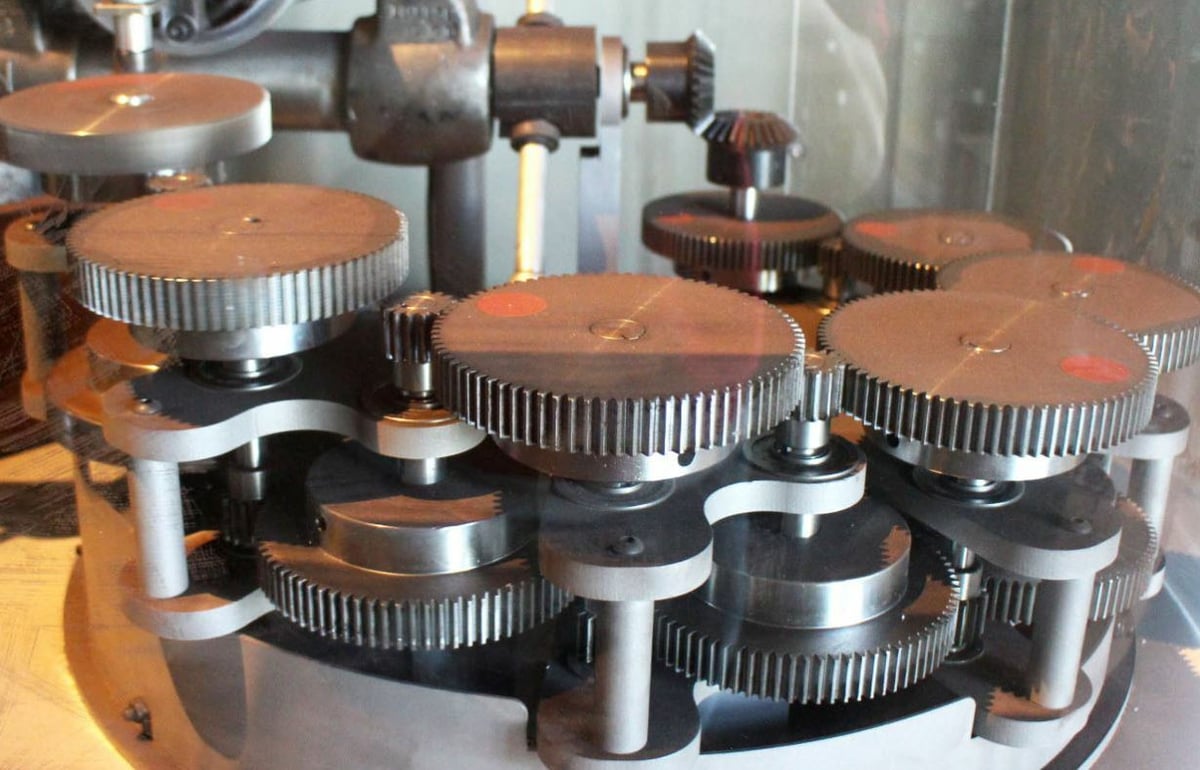
Nowadays, you can find millions of 3D models online that you can print, and, of these, complex mechanisms are some of the coolest designs out there. Complex mechanisms are advanced mechanical assemblies that use different forms and relationships of motion to move an object (or objects) in an untraditional way.
These types of designs usually require 3D printable pieces and some hardware like screws, nuts, or pins to complete the assembly. Although complex mechanisms can be used in many ways, their primary purpose is to visually demonstrate a unique type of mechanical motion.
In this article, we’ll be going over 10 amazing complex mechanisms that you can 3D print. For each selection, we’ll briefly cover how the mechanism works, how to print it, who made it, its popularity, and where to find it.
If you see a mechanism on the list that you like but don’t have the time or means to print the parts yourself, try Craftcloud by All3DP. With a huge range of materials and finishes, you’ll be able to easily customize how you want your parts to look and feel.
Now, get ready to be impressed with these complex mechanisms!
Iris Box

First up is this box which utilizes the motion of a typical iris door (inspired by the iris of your eyes), with curved slices shifting inwards when the frame is rotated. The slices of the door move on a straight path, but because they are curved, the door looks like it’s closing by rotation. This design is actually the third version of the creator’s original, with improvements to the box’s assembly.
The box is made up of five different 3D printed parts and a few small screws that keep the box together. The designer provided step-by-step instructions to make this box in the TXT file included on the project page. The maker of this mechanism also listed that they printed the pieces in ABS, using a 10% infill density (0% for the base) and 2 shells (1 for the leaves).
- Who designed it? countspatula
- How printable/popular is it? This iris box design has 81 recorded Makes, 7 Remixes, and over 43,00 downloads. So many people have printed this design; you can too!
- Where to find it? Thingiverse
Rack & Pinion

Second, rack and pinion is another popular type of motion. When the gear (pinion) is rotated, the rack moves along its defined axis path. The gear has twenty teeth while the rack has fifteen, both with a module of two millimeters.
This rack and pinion project is made up of three 3D printable parts and a few screws which hold the parts to the frame piece.
Worm Gears

Third, worm gears are somewhat similar to a rack and pinion mechanism, but they involve a threaded screw figure instead of a rack. The mechanism works when the gear is rotated, and the connected threaded figure rotates; it’s the same in reverse.
The assembly is made up of six different 3D printable components and requires no screws, as the frame contains built-in hardware to hold the other pieces. The designer listed the model as support-free, but there are no further printing suggestions.
- Who designed it? LiveIn3D
- How printable/popular is it? This worm gear model has almost 1,600 views as well as 68 downloads.
- Where to find it? MyMiniFactory
Geneva Drive
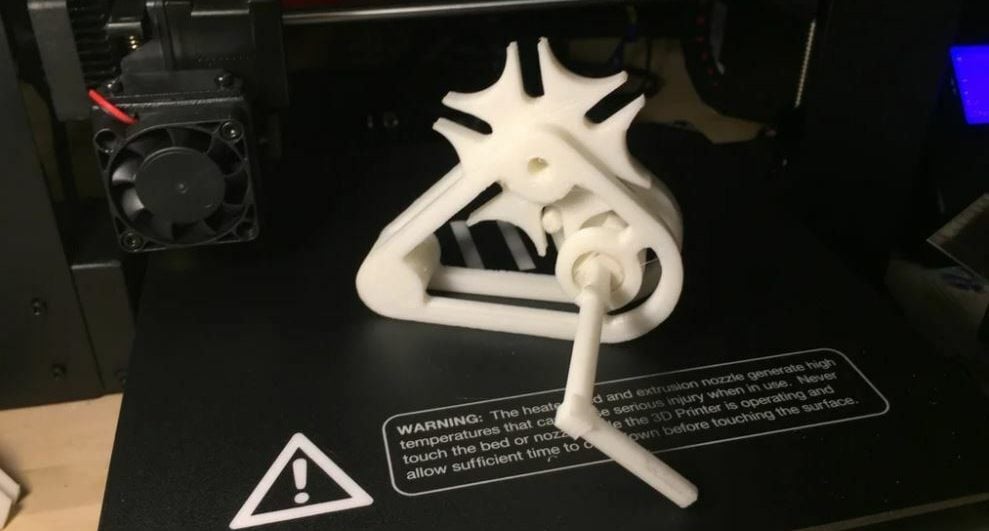
The Geneva drive is another widely-known mechanical design that converts continuous rotational motion into intermittent rotational motion. The motion is interesting to learn about and visualize, making this design a great mechanism to print.
True to its name, the Geneva drive is comprised of a “rotating drive” wheel with a pin and a “driven” wheel with a pin slot. When the rotating wheel comes to the pin slot on the driven wheel, it moves the driven wheel until the pin comes out of the slot. This creates intermittent rotary motion, with the driven wheel moving only a small proportion on the drive wheel. For more information, you may want to check out Maker’s Muse’s video explaining the motion.
The designer listed that they used a Wanhao Duplicator i3 V2 for printing, with the parts at a layer height of 0.1-0.2 mm and a 15% infill density. They also activated supports to print one of the parts.
- Who designed it? xlRadioActivelx
- How printable/popular is it? This Geneva drive has 18 recorded Makes, 1 Remix, and over 24,000 downloads! With so many successful prints in the books, you should easily be able to print this design!
- Where to find it? Thingiverse
One-Way Bearing
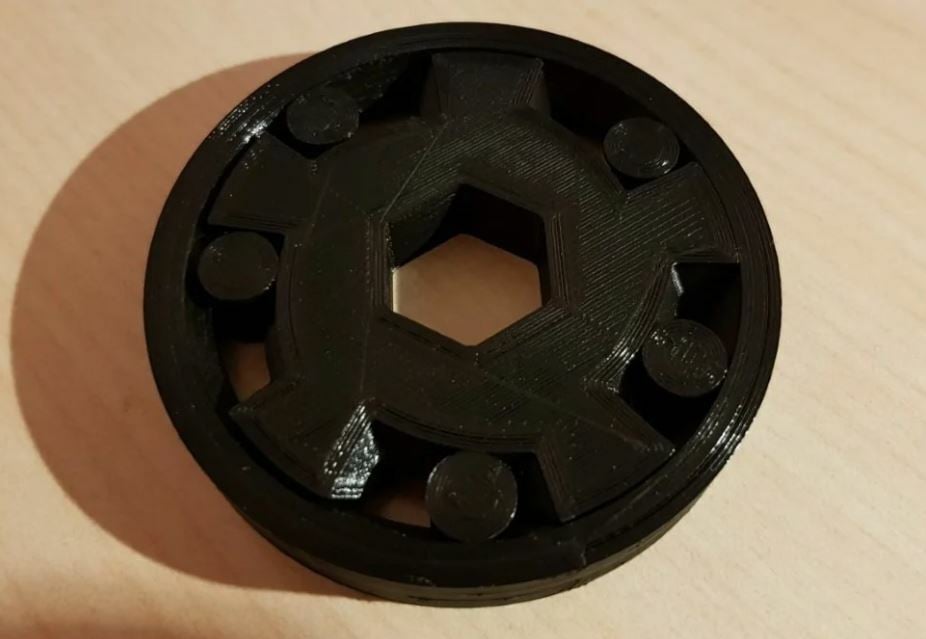
Next, this one-way bearing mechanism functions like a free-rolling bearing when rotated in one direction and locks when rotated in the other. The bearing is a one-piece print and the designer stated that the model was optimized to work even when printed with low dimensional accuracy.
This mechanism was designed in SolidWorks and the model file is included if you’d like to have a look or make any adjustments.
- Who designed it? lalalandrus
- How printable/popular is it? This one-way bearing mechanism has 1 recorded Make and over 2,300 downloads.
- Where to find it? Thingiverse
Retrograde
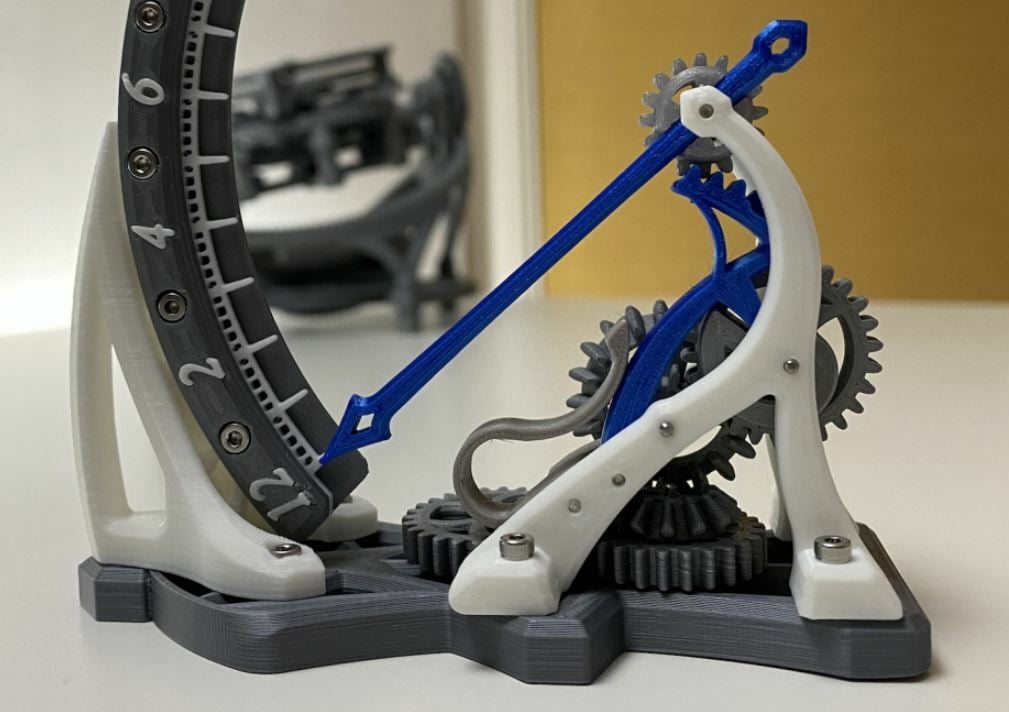
Next, this retrograde mechanism is a complex mechanical motion instrument that’s actually used in some high-end watches, according to the designer. It rotates an object (the ticker hand in the image above) along a curve and, after it reaches the top, the object falls back to its initial position.
This mechanism is pretty unique, requiring a total of 18 printable pieces and a host of non-printable components, all of which the designer listed on the project page. As you can imagine, assembly for this mechanism is pretty intricate but there’s an assembly video to make this process easier.
The designer stated that they used a 0.3-0.4-mm nozzle on a Creality Ender 3 with a resolution between 0.1 and 0.2 mm to print the pieces.
- Who designed it? Mechanistic
- How printable/popular is it? This retrograde mechanism has 1 community print, almost 21,000 views, and around 3,000 downloads.
- Where to find it? MyMiniFactory
Planetary Gears
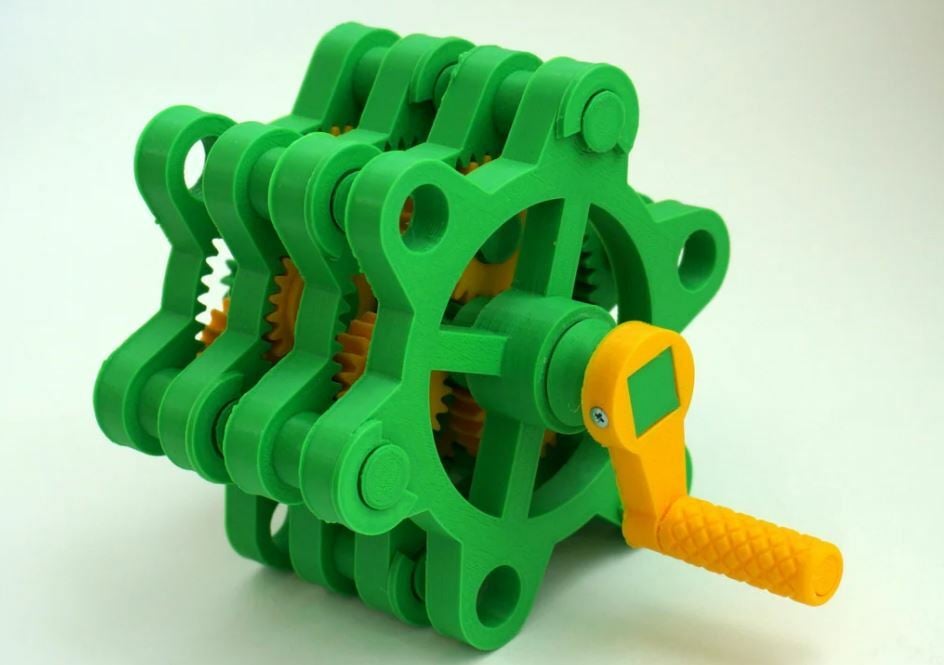
Planetary is a popular gear relationship for rotational motion, used in devices like motor gearboxes and advanced robot assemblies. The system works with an internally toothed frame known as the ring, which holds a few gears or planets inside. The teeth of these planets are interlocked onto the frame, so they spin around it.
The planets are all connected by a carrier piece that spins as the planets go around the ring. To move the planets, a smaller gear piece (known as the “sun” in the system) lies in the center of the assembly with its teeth interlocked into those of the planets.
When the sun is spun, the planets spin around the ring. As the planets move, the carrier rotates at a smaller proportion of the input speed (sun rotation speed). Planetary gearboxes for motors can be speed-increasing or reducing, depending on weather the motor is connected to the carrier piece (speed-increasing) or the sun gear (speed-reducing).
The configuration in the image above shows a 1:216 ratio: For every 216 spins of the handwheel connected to the sun, there’s 1 rotation of the carrier on the furthest assembly.
Many printed and non-printed parts make up this stackable gearbox, including screws and washers. For the full list, you can check out the project page. The creator of this design stated that they printed the pieces for this assembly on a MakerGear M2 with no raft or supports activated.
- Who designed it? otvinta3d
- How printable/popular is it? This planetary gearbox model has 13 recorded Makes, 5 Remixes, and over 24,000 downloads. As there are so many Makes with listed slicer settings, you can check out others’ settings to successfully print this model.
- Where to find it? Thingiverse
Nautilus Gears
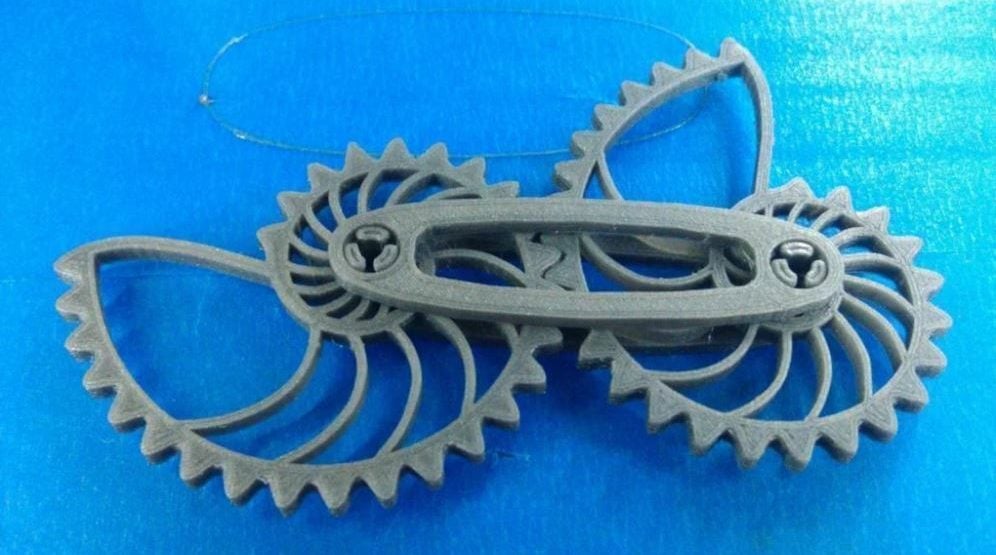
For all you math lovers, the Nautilus gears are shaped in Fibonacci spirals, following the graph of the Fibonacci sequence. When assembled correctly, the gears will never miss each other and will always be connected at one location, even though they aren’t circular.
The design comprises four parts (including printing the gear piece twice) and requires no hardware for assembly, as the frame component has built-in fastenings for holding the gear pieces. One recorded Maker posted a successful print with a 0.2-mm layer height, a 10% infill density, a raft, and no supports.
- Who designed it? MishaT
- How printable/popular is it? This Nautilus gear design has 558 recorded makes, 26 Remixes, and over 234,000 downloads. The high number of Makes indicate that this model is very printable.
- Where to find it? Thingiverse
Spherical
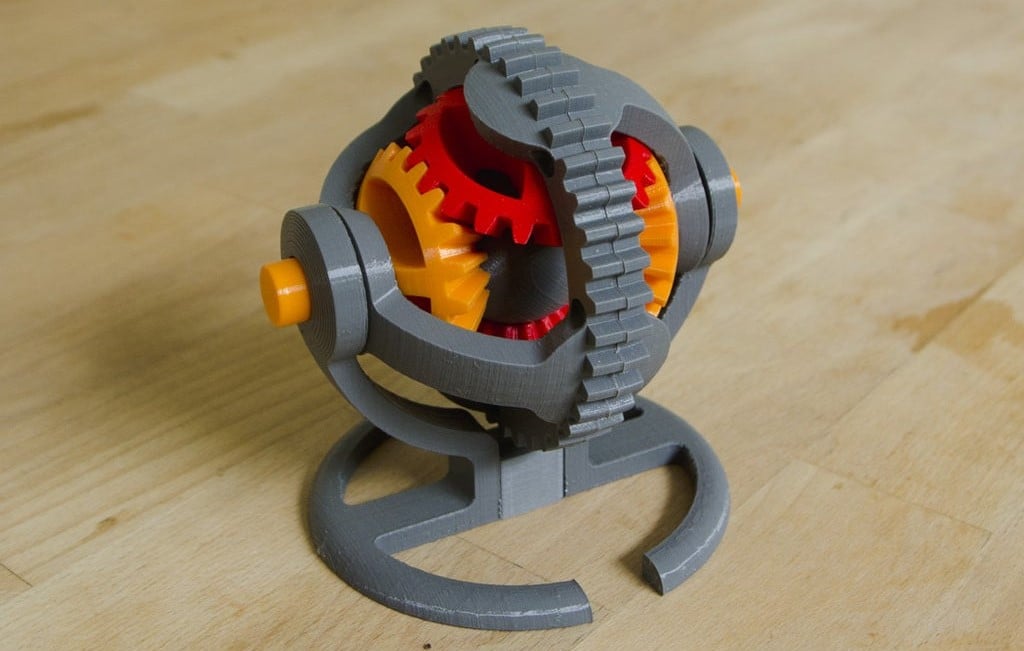
Next, just by looking at the image above, you can probably tell this mechanism is on the more complex side of the selections on this list. It uses an array of circular and angled gear relationships to convert rotational motion in one direction to spinning motion at a 90° angle to the input motion.
The circular end pieces can be rotated with (or without) the printable handwheel piece, and this spins the unique gears inside the assembly (orange and red in the image above). These gears will rotate the larger spherical frame in a perpendicular direction. If you spin the handwheels on both sides in opposite directions, the spherical frame will stay in place.
The design uses a fair number of 3D printed parts (around 15) and requires 5 screws to bind the different pieces. Also, the designer listed that they printed the model with a 20% infill density, using both a raft and supports, on an Ultimaker 2 machine.
- Who designed it? SavageRodent
- How printable/popular is it? This spherical mechanism has 31 recorded makes, 2 Remixes, and over 41,000 downloads.
- Where to find it? Thingiverse
Spiral Hoop Gear
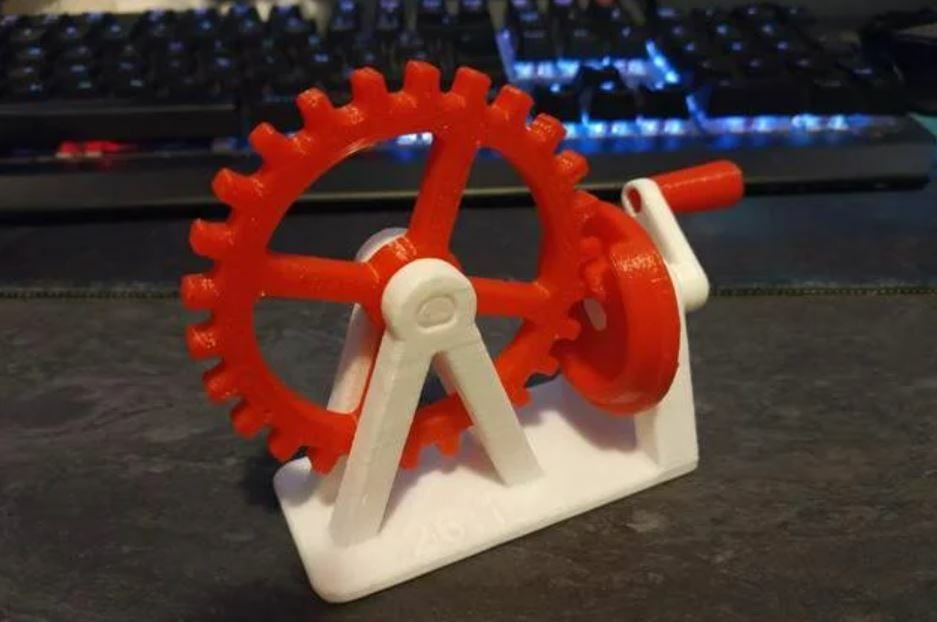
Lastly, this spiral hoop gear is similar in concept to the rack and pinion and worm gear mechanisms, but it uses a spiral hoop instead of a rack or threaded screw to move the connected gear. When you spin the handle, the spiralized hoop shape rotates, which turns the gear in one direction.
If you’d like to print this yourself, one recorded Maker listed a few of the settings they used to print a great model: 50% infill density with a 0.2-mm layer height and no rafts or supports.
- Who designed it? HenriDIY
- How printable/popular is it? This spiral hoop gear design has 5 recorded Makes, 1 Remix, and almost 6,700 downloads.
- Where to find it? Thingiverse
Lead image source: veggieramen via Thingiverse
License: The text of "3D Printed Mechanisms: Rack & Pinion, Iris Box, & More" by All3DP is licensed under a Creative Commons Attribution 4.0 International License.
